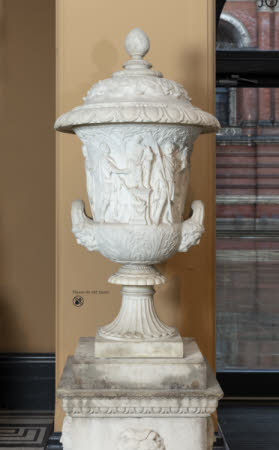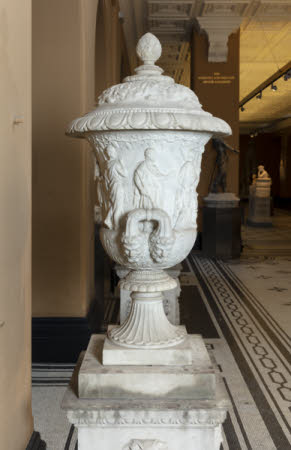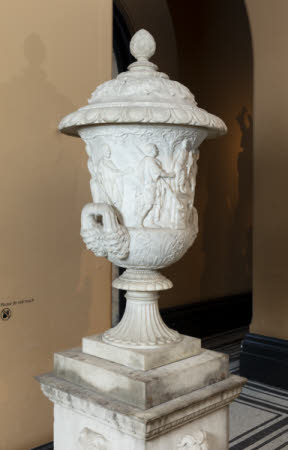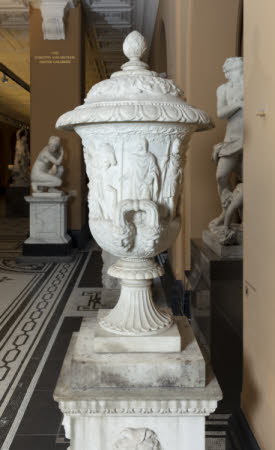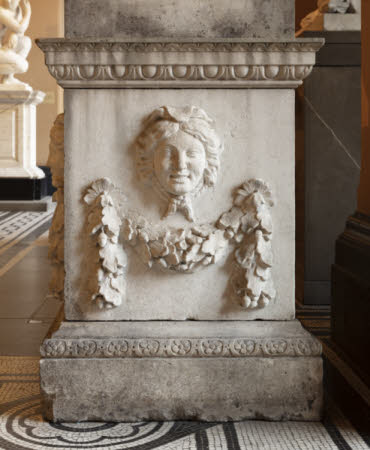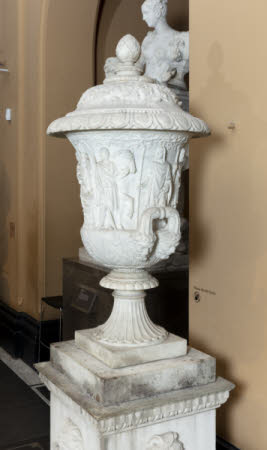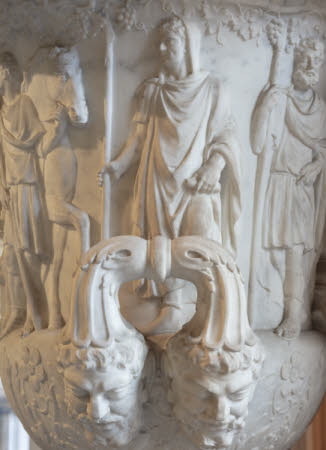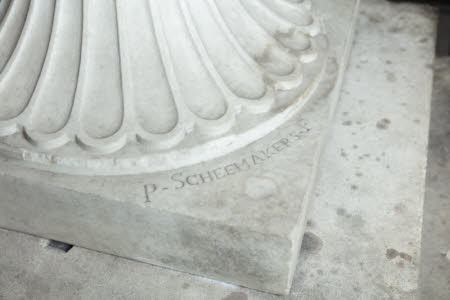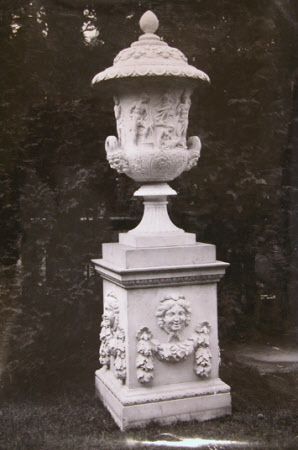Wanstead House Urn: Sacrifice to Apollo
Peter Scheemakers (Antwerp 1691 - Antwerp 1781)
Category
Art / Sculpture
Date
c. 1721 - 1728
Materials
Carrara marble
Measurements
1475 mm (Height)
Place of origin
London
Order this imageCollection
Anglesey Abbey, Cambridgeshire
NT 516663
Summary
Marble, Wanstead House Urn: Sacrifice to Apollo, Peter Scheemakers (Antwerp 1691 - Antwerp 1781), c. 1721-28, signed on front left corner of base: P. SCHEEMAKERS. F. One of four Carrara marble urns depicting sacrifices to Roman deities (Diana, Apollo, Hercules, Bacchus), produced c.1721-28 for Wanstead House; this urn one of two carved by Peter Scheemakers (with NT 516664), the other two by Laurent Delvaux (NT 516662, 516665). Mounted on a stone pedestal.
Full description
A bell-shaped lidded urn with an artichoke or pinecone finial, the lid enriched with alternating acanthus and scallop shell, pearl and egg and tongue moulding. The body with a bas-relief of twining grapevine and a high-relief frieze depicting a sacrifice to Apollo after the hunt. The scene, after an engraving by Pietro Santi Bartoli, combines the sacrifice to Apollo (the Apollini Sacrum) depicted on one of the Hadrianic tondi on the Arch of Constantine with figures of barbarians seen on Trajan’s column (Roscoe 1999, no. 233, p. 292). Cloaked hunters gather around a statue of Apollo Citharoedus (with lyre, resting on a tripod) mounted in a grove of laurel trees. The figure to the left of Apollo makes an offering to the sacred fire, his spear pointing towards the flames. The figure to the right (an emperor in the tondo) holds the reins of his horse with one hand and points his spear towards Apollo with the other. Loop handles rise from paired satyrs’ heads at either side of the bowl, carved with scrolling foliage and rosettes. The fluted stem is enriched with pearl, layered acanthus and ovoid ornament. The vase is mounted on a square base and on a separate stone pedestal with egg and dart and rosette moulding and four central masks in the form of female heads, smiling, with plaits tied under the face, supporting festoons of oakleaf and acorn. The Flemish sculptor Peter Scheemakers (1691-1781) came to London in 1720, finding work as a modeller and carver in the Westminster studio of Denis Plumier (1688-1721). There he met Laurent Delvaux (1696-1778), a fellow Fleming. After Plumier’s premature death in 1721 Scheemakers and Delvaux went into business, inheriting their master’s prestigious commission for the Duke of Buckingham’s monument at Westminster Abbey. The two men established premises in Millbank, then a centre for contemporary sculpture situated near stone wharves and marble merchants on the Thames. Following the success of the Buckingham monument, in partnership, Delvaux and Scheemakers continued to produce funerary monuments as well as some figural groups (e.g. Vertumnus and Pomona, inv.no. A.1-1949, Victoria and Albert Museum, London, a pendant by Delvaux to Scheemakers’ Apollo and Venus, private collection) and recumbent statuettes (e.g. Ariadne and Cleopatra, inv. nos. B1977.14.31 and B1977.14.30, Yale Center for British Art, Paul Mellon Collection). Their work for Sir Richard Child, Viscount Castlemaine (1680-1750), was first recorded in 1722 in the notebooks of George Vertue, who wrote that a ‘Marble Statue of Hercules 6-foot high’ had been completed ‘for the Lord Castlemane by…Delvo’ (Avery 1980, p. 156). This was to be mounted with a pendant, a statue of Omphale carved by Scheemakers, in the gardens of Wanstead House, Castlemaine’s palatial Palladian mansion completed the same year. A pen, ink and wash design for the statues attributed to Scheemakers is in the V&A, London (inv.no. D.1062-1887); see also Jacobs 1999, no. S2a, p. 223, who attributes the drawing to Plumier. It is likely, then, that the four urns were ordered around the same time as the statues, and certainly before Delvaux and Scheemakers left for Italy in 1728. A guidebook of 1793 records the urns in the Great Hall of Wanstead House, arranged similarly to a comparable suite of four white marble urns in the Marble Hall at Osterley (NT 772411-772412). These works remained at Wanstead for the next century until the house and its contents were sold in 1822. Hercules was eventually acquired by Baron Ferdinand de Rothschild for Waddesdon Manor (inv.no. 6132.2) and the urns were bought at the 1822 sale by the Bristolian merchant-banker Philip John Miles (1773–1845). They were at the Miles estate, Leigh Court, until 1917. Despite the high quality of Delvaux and Scheemakers’ output, the partnership was not a commercial success and in 1728 the sculptors advertised their intention to travel to Italy ‘to form & improve their studies’. To have trained in Italy was advantageous in the business of art; to publicise it in a newspaper puff, Ingrid Roscoe writes, was a ‘ploy’ which the partners hoped would secure their ‘reputation as the leading London specialists in classically inspired sculpture’ (Roscoe 1999, p. 163). In the event, Scheemakers returned alone to England two years later, leaving Delvaux ‘well imployed’ in the papal court in Rome (Vertue quoted in Avery 1980, p. 166). Delvaux came back to London in 1733, selling several of his sculptures to Scheemakers, who in turn sold them to the Duke of Bedford, before finally settling in the Austrian Netherlands (now Belgium) as a successful court sculptor (Avery 1980, pp. 167-8). The four Wanstead urns take the form of the Medici Vase, one of the most famous and widely imitated of all antique garden ornaments in the Western canon. A colossal bell-shaped krater, the Medici Vase was sculpted in Athens between around 50 and 100 AD and was installed in the gardens of the Villa Medici, Rome, before being transferred to the Uffizi in Florence, where it remains today (Haskell and Penny 1981, no.82, p.316). The vase is enriched with a deep relief frieze said to depict the sacrifice of Iphigenia to the goddess Diana. A close version of this relief is found on one of the two urns by Delvaux (NT 516662); the other, NT 516665, carved with a version of the relief frieze found on the Borghese Vase showing a bacchanalian procession. Typically paired with the Medici, the Borghese Vase is an equally celebrated Attic krater acquired by the Borghese family and later transferred to the Louvre, Paris (Haskell and Penny 1981, no.81, p.315). Scheemakers also looked to antique prototypes, deriving his reliefs for NT 516663 and 516664 from two of the Hadrianic tondi on the Arch of Constantine, depicting the Apolloni Sacrum and Sylvano Sacrum. Both sculptors are likely to have worked from engravings; see Francois Perrier Icones et segmenta...quae Romae adhuc extant (Paris, 1645), a repertory of Roman antiquities used by generations of European artists and connoisseurs, and Pietro Santi Bartoli (1635-1700) Admiranda Romanarum antiquitatum (see plates 18-9, 50-1) and Veteres arcus Augustorum triumphis insignes (see plates 33, 27). See the set of four highly influential urns carved by Jean Cornu in 1683 for the Parterre de Latone Versailles (MR 2794-7). The lids of the Wanstead urns are close to those on the vases by Jacques Grimault, c. 1672, also in the Parterre (MR 2805-6). An urn of the Wanstead type can be seen in a design for a funerary monument by Scheemakers, undated, in the V&A (inv.no. D.1057-1887). Errata: Catalogue of Wanstead House Sale, Robins, London, 10 June - 23 July 1822, lots 369-72, pp. 124-5): Scheemakers listed incorrectly as the sculptor of lot 369 (NT 516662, Delvaux, Sacrifice of Iphigenia to Diana) and Delvaux as the sculptor of lot 372 (NT 516664, Scheemakers, Sacrifice to Hercules). John Rutter, Delineations of Somersetshire (1828), the sculptors confused in the description of the Great Hall, Leigh Court: ‘…the floor is of chequered marble, on which are four magnificent vases, that were brought from Wanstead House, one pair from the antique, by Delvaux, representing an heroic subject, and a sacrifice to Apollo. The second pair are sculpted by Scheemaker, to one of them a bacchanalian subject, and on the other, the sacrifice of Iphigenia, from the Medicean Vase’ (p. 264). Alain Jacobs, Laurent Delvaux, 1696-1778 (Arthena 1999): Delvaux’s urns are catalogued as those by Scheemakers and Scheemakers’s as those by Delvaux. Alice Rylance-Watson 2019
Provenance
Commissioned by Sir Richard Child, Viscount Castlemaine (1680-1750) between 1721 and 1728; sold Wanstead House Sale, Robins, London, 10 June-23 July 1822, lot 369; purchased by Philip John Miles (1773–1845) of Leigh Court; sold by Sir Charles William Miles (1883–1966) in 1917 (no sale catalogue); purchased at an unknown date by Bert Crowther of Syon Lodge; purchased by Huttleston Rogers Broughton, 1st Lord Fairhaven (1896-1966) 31 March 1942 from Bert Crowther £250, ‘a set of 4 carved marble vases on carved stone pedestals’; bequeathed to the National Trust by Huttleston Rogers Broughton, 1st Lord Fairhaven (1896-1966) with the house and the rest of the contents; on loan to the Victoria & Albert Museum, London, February 2006 to March 2021; currently on display at Croome Court.
Credit line
Anglesey Abbey, The Fairhaven Collection (The National Trust)
Marks and inscriptions
On front left corner of base: P. SCHEEMAKERS. F.
Makers and roles
Peter Scheemakers (Antwerp 1691 - Antwerp 1781) , sculptor
References
Avery 1980: Charles Avery, 'Laurent Delvaux's Sculpture in England', National Trust Studies, 1980, pp. 160-6. Jacobs 1999: Alain Jacobs, Laurent Dalvaux 1696-1778, Paris 1999, pp. 23-34, 233 (no. S2), 228-31 (nos. S6, 6a, 7, 7a, 8). Roscoe 1999: Ingrid Roscoe, 'Peter Scheemakers', The Volume of the Walpole Society, vol. 61 (1999), pp. 163-304. Haskell and Penny 1981: Francis Haskell and Nicholas Penny, Taste and the Antique, The Lure of Classical Sculpture 1500 - 1900, New Haven and London, 1981, pp. 315-6, nos. 81-2. Roper 1964: Lanning Roper, The Gardens of Anglesey Abbey, Cambridgeshire. The Home of Lord Fairhaven, London 1964, p. 39, pls. 12-13a. Christie, Manson & Woods 1971: The National Trust, Anglesey Abbey, Cambridge. Inventory: Furniture, Textiles, Porcelain, Bronzes, Sculpture and Garden Ornaments’, 1971, p. 172.
